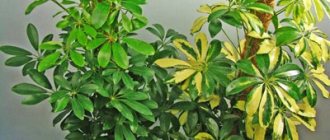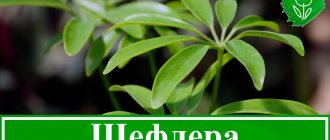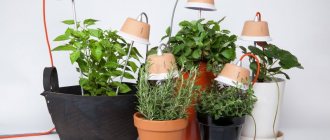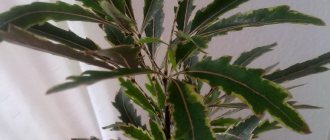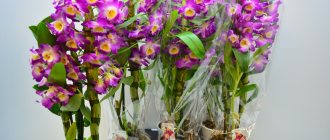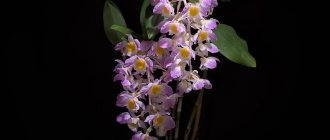Growing Schefflera Janine
This is one of the most beautiful subspecies. It has rosette-shaped foliage, colored green-yellow, which in the sun acquires white spots and streaks. As it is also called, “Schefflera arborescens” grows easily and without special care in humid and warm climates; you just need to place the pot with it in partial shade.
Features of care
- A correctly chosen place is the key to the healthy development of this flower. It does not tolerate direct rays of the sun, but cannot maintain the bright color of the leaves without light, so you need to choose a place where it will be illuminated by a diffused stream.
- In winter, the room temperature should not be lower than 14°C, and in the summer heat - exceed 25°C.
- Moderate watering is the best hydration. Schefflera can die from waterlogging, but very dry soil will harm it. Therefore, during cold periods you should not water it often, and during hot periods you should additionally humidify the air around it or place a tray with pebbles next to it. Periodically, you need to wipe the leaves with a damp sponge and expose it to the open air.
- From spring to early autumn it is necessary to fertilize. During this period, the active growth of this plant occurs. Therefore, such assistance should be provided every week.
General description of the flower
There are about 200 different species of Schefflera in the wild. This plant is sometimes called a tree plant. Latin name: "Schefflera Arboricola Janine". This amazing plant stands out among other representatives of the flora.
"Schefflera" is endowed with the most beautiful leaf shape. They look like a rosette-shaped, spreading structure. And their structure resembles an amazing umbrella with rays of the sun. The colors of the flowers are different. Sometimes they are completely emerald, but in most cases they are amber with snow-white spots.
In the sun they acquire snow-white streaks in the middle of the leaf. Unfortunately, this exotic pet does not bloom in indoor conditions. But the unusual shape and color of the leaves completely compensates for the lack of flowering. “Schefflera Janine” is one of the incomparable subspecies.
Reproduction Schefflera Janine
It can be produced:
- cuttings;
- seeds;
- air layering.
Wooden cuttings are cut with a sharp knife, treated with a hormonal solution and immediately planted in a substrate prepared in advance. It consists of sifted sand and peat. And then cover with a regular bag, glass container or cut plastic container. For this type of reproduction it is necessary to create a temperature of 22°C.
Seeds are used extremely rarely. They can be planted in early spring under homemade greenhouses and constantly maintain a temperature of at least 18°C.
Schefflera itself does not produce layering for propagation; it must be grown. First, an incision is made on the trunk of the plant, then moss is applied and everything is wrapped in polyethylene. This place must be constantly kept moist. The first shoots should appear in two months. They are cut and planted in pots.
Varietal characteristics
The genus Schefflera includes more than 200 plant species, all of which belong to the Araliaceae family and grow in hot tropical forests. Schefflera looks like small trees or shrubs, with very elegant foliage. Each of its sheets is shaped like a palm with outstretched fingers; there can be from 4 to 12 such “fingers” in one sheet. Sometimes the plant is called an umbrella tree, for its resemblance to an open umbrella. It is kept in the room because of its elegant foliage; flowering in captivity is a rare miracle.
- The most famous representative is Schefflera digitata, its homeland is New Zealand, it is an endemic plant.
Endemics are those plants that grow only in a specific place on the globe.
In tropical forests it reaches a height of 8 meters. Its leaf is divided into seven parts resembling fingers. The leaf plates are soft and thin, the edges are pointed. The flower resembles a branched panicle; large flowers can reach 40 cm in diameter. When the flower fades, a purple fruit appears in its place, which is eaten with great pleasure by birds and insects. The life of this variety has long been under threat; local residents take great pleasure in selling this plant to tourists, thereby disrupting its population.
- Schefflera actinophylla (Schefflera actinophylla), it is also often called “green star”. This is an evergreen tree, reaching a height of 10 - 15 meters, from one or several trunks. This species is characterized by elegant serrated leaves from 30 to 60 cm in length. One leaf consists of 7 – 16 toothed leaves. It blooms with small flowers, united in inflorescences; after they wither, a purple fruit appears, suitable for birds and insects. Schefflera stellate (star-leaved) can be grown from seeds in a greenhouse.
- Schefflera octophylla is a species native to the subtropical forests of India, Japan and China. In nature, it is a shrub or tree that can reach a height of 2 meters. Its young leaves are covered with light needles, which disappear with age. Each leaf is divided into eight small oval plates.
- Schefflera arboricola is the most numerous species and the most popular in indoor floriculture. You can find the name Schefflera Arboricola after the Latin name of the plant. In its natural habitat it grows as a small shrub, but can grow as a small vine. This species only grows up to 3 meters in height. At home, you can most often find the Tree Schefflera, the care of which is quite simple, so it is considered an unpretentious decorative foliage plant. A popular flower for landscape design and apartment interiors. Tree Schefflera can most easily be propagated by cuttings or air layering. It is better to obtain cuttings in the warm season from the spring until autumn, during the period of active growth and development of the plant. The young shoot is cut off and placed in water; you should choose a bright place where your pet will produce roots. After two weeks, when the roots appear, the shoot can be planted in a prepared pot for further development. Caring for a tree representative at home can be considered basic. However, you need to follow simple rules in order to grow a beautiful “creature”. The tree is a light-loving palm tree, but open sunlight can cause burns to the leaves. You need to choose a bright place near the window; you should immediately abandon the window sill on the south side. In summer, the bright sun “rages” on the southern window. Constant soil moisture is beneficial for the plant; you need to stick to the “golden mean”; stagnation of water at the roots will lead to their rotting and death of the trunk and root system. The optimal temperature is considered to be from +15 to +20 degrees all year round. Feeding should be carried out as planned from spring to autumn, during the period of active growth. Any fertilizer is suitable for “ornamental deciduous plants.” As for replanting, young plants can be subjected to this procedure annually, increasing the new pot by 1-2 cm, but for an adult, strong tree, once every 2-3 years is enough, changing the flowerpot for Schefflera and renewing its filler. Land can be bought at any flower shop, suitable for palm trees or home flowers.
- Now there are many varieties classified as Schefflera Variegated, bred specifically for landscape design and apartment decor. Schefflera Gold Capella is one of the most favorite forms of this species among gourmet gardeners. This palm is native to South Asia. It goes well with other home colors, creating wonderful interior ensembles. Its main advantage is its glossy, fleshy leaves, reminiscent of fingers spread out in different directions. Whatever the care, at home Schefflera Gold Capella blooms extremely rarely or does not bloom at all. Golden Capella grows and develops well in places with diffused light. In the dark corners of the apartment, elegant variegated foliage takes on a monotonous green color. When kept in dark rooms, artificial lighting must be provided.
- Schefflera Gerda is not picky about home care. She prefers diffuse lighting. When grown indoors (at home), it reaches a height of 50 cm to 2.5 m, while much depends on the conditions of detention. Moderate humidity of the substrate is suitable, without stagnation of water and drying out of the earthen coma. The color of the foliage is variegated: from white-green to yellow-green.
- No less elegant variety Scheffler - Amate. It attracts the attention of gardeners with its shiny waxy leaves and resistance to pests of indoor plants (thrips, scale insects, spider mites). The Amate variety is not demanding of light, can be in significant shade and is suitable for apartments and offices with windows facing north.
- One of the most elegant representatives of the domestic species is Louisiana; its decorative openwork leaves do not leave indifferent even the most favorite gourmet gardeners. The leaves are leathery, shiny, and can be variegated with patches of yellow or white. The presence of spots is determined by the sunnier side of keeping the flower at home. Scheffler Louisiana is not demanding when it comes to caring for it; you need to follow the general tips for maintaining this type of indoor plant.
- Schefflera tree Gianni (there are many variations of names, such as Janine, Zhanni or Janine) has all the known advantages of the whole species and ease of care at home. It is popular for its elegant variegated foliage. The light green of the leaf is diluted in a chaotic manner with dark inclusions and stains. Gianni tolerates partial shade or shade well, without losing its variegated leaf color.
- The Scheffler Charlotte variety was developed not so long ago, but has already gained popularity among landscape designers. The outer part of the leaves is light in color, with a dark green edge visible at the edges, but on the back side of the leaf the color is more saturated and dark. In general, it resembles an open rosette. Used as an ornamental foliage plant for landscaping residential and office premises. When it comes to care, it prefers the same things that are typical for all types of these palm trees.
- Green Star (Green Gold) is one of the recently bred varieties; its distinctive feature is fleshy dark green leaves that attract close attention. Prefers high air humidity and practically does not bush. If your interior does not have enough rich green color, you can try growing Schefflera Green Star from seeds, buying them at a flower shop. Planting in the ground is best done in the spring (late February - early March, April) during the period of active growth and development of all domestic flowers. The seeds are placed in a moist substrate; the top of the pot can be covered with film, but when the plant hatches, the film should be removed. The container with sprouts must be placed in a bright place, but not in the sun, otherwise the delicate foliage may get sunburned and die.
- Schefflera Nova (or Nora) attracts gardeners with its elegant foliage and ease of care at home. It has very long narrow dark green leaves, not evenly toothed at the edges. The color of the leaves is light olive with splashes of yellow. All year round it will delight you with its lush crown.
- Schefflera Melanie, another beautiful species of Schefflera tree. It differs from other varieties in the fine variegation of its leaves and elegant crown.
- Among the many varieties bred, Schefflera Bianca deserves special mention. It has shorter leaves compared to other varieties: about 8 cm in length. Each leaf has a white edge and beige tones at its base. Due to the contrasts of colors, light and dark, the serrations along the edges of the leaves stand out less clearly. It is worth noting that care for Schefflera Bianca is the same as for the parent of the species. At home, you should organize abundant watering, drying the top layer of soil, apply complex fertilizers every 2 weeks from May to August and set the temperature in the summer to within 22 °C, and in the winter to about 18 °C.
- Schefflera Caster is famous among flower growers for its decorative sizes; it is perfect for small apartments and rooms. If you have little space for a large palm tree, then you can safely opt for this variety of shrubs.
- In a flower shop you can often find plants labeled Schefflera Mix; a novice florist always asks the question “how to care for this variety at home.” In a pot marked Mix, you can safely find any representative of this genus. As for care, you need to adhere to the basic rules for growing this species in residential (or non-residential) premises.
Schefflera transplant Janine
It is necessary to purchase special soil for palm trees. Be sure to choose good drainage; medium-sized expanded clay, gravel or ceramic fragments will do. They need to fill the pot about a quarter full.
Young plants and already mature ones need replanting. This must be done every two years. The pot is selected with a diameter 5 mm larger than its previous counterpart. Transplantation is carried out by transshipment, during which the roots will not be damaged. Then the earthen lump with the flower is transferred to a pot and covered with soil to the brim. Then water it abundantly.
Caring for shefflera at home. Briefly
| Temperature | In summer - 20-25 degrees, in winter - 18-20 degrees, but not lower than 12 |
| Air humidity | High, regular spraying is recommended. |
| Lighting | Schefflera at home needs bright diffused lighting, the optimal place is an eastern window sill. |
| Watering | Moderate, avoid waterlogging; in summer – 2-3 times a week, in winter – once every 7-10 days. |
| Priming | Nourishing, lightweight, breathable. |
| Feeding and fertilizer | During the growing season, apply liquid fertilizer for decorative foliage plants once every 2 weeks. |
| Transfer | Once every 2-3 years, the top layer of soil in the pot is replaced annually. |
| Shefflera propagation | Apical cuttings, layering, seeds. |
| Peculiarities | It requires support and sometimes pinching to form a bushy shape. |
Diseases and pests Schefflera Janine
They are only associated with improper care. But timely identification and quick elimination of the causes of the disease will not affect the decorativeness of the plant. Mostly they encounter the following diseases:
- active shedding of leaves - caused by low temperatures or excess moisture. It is necessary to immediately move the flower to a warmer place;
- brown edges or darkened spots are a sign of poor watering or drafts;
- Root rotting - excess moisture. It is urgent to transplant the plant into new soil;
- the appearance of various pests (thrips, mites or scale insects) on the surface of the leaves. There are several methods to get rid of them. The simplest thing is to wipe the leaves, especially their insides, with a soapy solution. If this procedure does not help, insecticides or fungicides should be used.
Schefflers Janine are distinguished by their beauty, originality and height (can reach 2 meters). Its appearance will attract the attention of any guest and add a tropical touch to the interior of the room.
Lighting
Schefflera is moderately demanding of good lighting and will happily extend its palm-shaped leaves to the light. The ideal window is southern, acceptable are western and eastern.
Advice: if you want to have this plant, but the room is annoyingly dark, or the pot will be located not on the window, but in the back of the room, choose green rather than variegated types of schefflera. Variegated Schefflera have higher light requirements than regular green ones.
In the summer, the plant will be comfortable moving into fresh air. Watch out for scorching rays: they can burn the leaves, so take care of shading the bush during the active time of the sun.
The meaning of sheflera in folk signs
Many superstitions collected among the people are closely related to this indoor plant. There is an opinion that the flower is a real “good vampire”, absorbing the negative energy of those around.
Indeed, many gardeners have noticed the positive effects of this plant. It is attributed to the chefler's abilities:
- harmonize the atmosphere around you;
- remove negativity;
- stop quarrels between family members.
It is best to place the potty with the green “helper” in the sleeping bag. Plant energy:
- strengthens sleep;
- will improve the relationship between spouses.
Sheflera can add a pinch of harmony to your life
In addition, there is an opinion that if you carefully observe a flower, you can draw a logical connection between changes in its appearance and events in the life of the family:
- if the leaves begin to darken, a lot of negative energy has accumulated in the house;
- if the leaves begin to fall, one of the family members may become seriously ill;
- a sharp drop of foliage often marks serious financial losses;
- when the leaves begin to curl, a quarrel will occur between friends, family members, colleagues;
- when the plant began to actively grow, and then these processes stopped, you need to prepare for failures in work, with loved ones;
- The cheflers associate rapid growth with future pregnancy.
We believe that the cheflera will bring joy and good luck to its owner!

